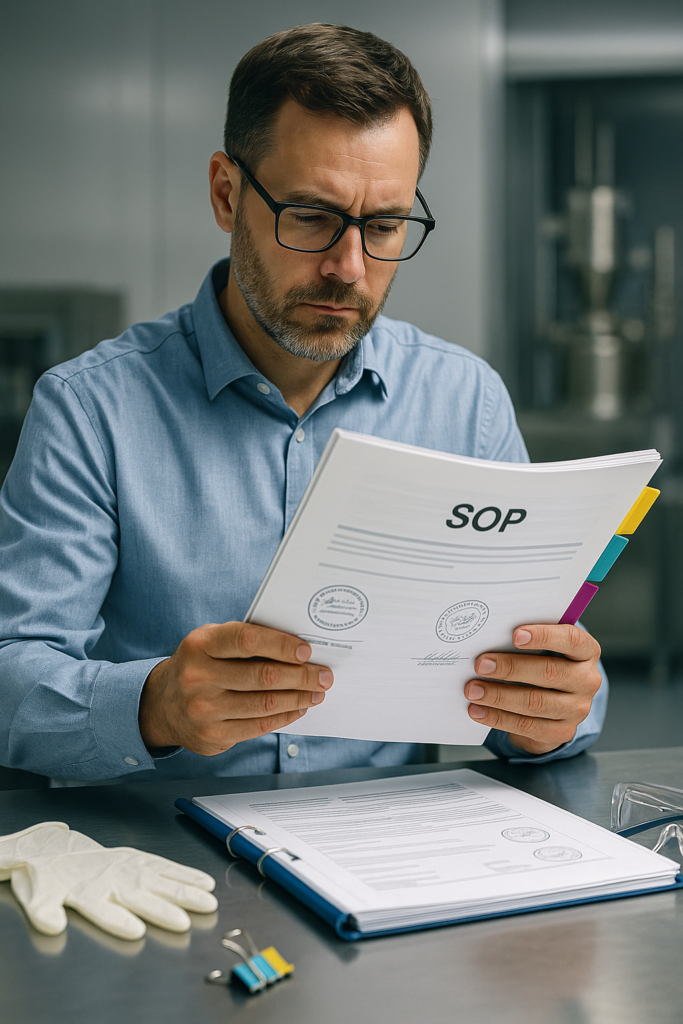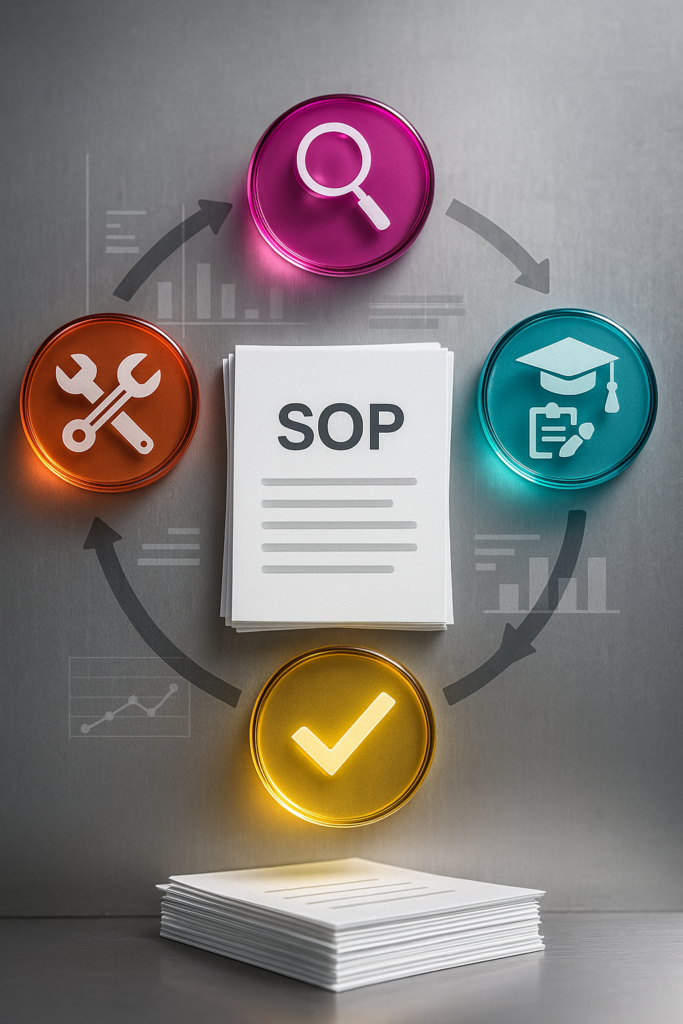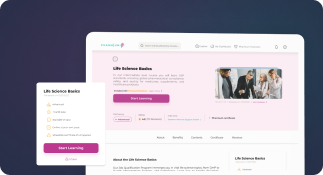Auditors love clarity. Your SOP must deliver it on every line. Teams need steps that reduce risk, speed execution, and stand up under pressure. Therefore, this guide shows you how to write an audit-proof SOP section that works in real operations and withstands regulatory scrutiny. You will see structure, wording, controls, and training tactics that pass audits and improve performance. Moreover, you will learn how CAPA loops connect to SOP quality.
Compliance should not slow the process. Instead, it should drive consistency and trust. Consequently, an audit-proof SOP sets expectations, reduces ambiguity, and prevents deviations before they start. Additionally, it provides a single source of truth for cross-functional teams. Use the templates, lists, and checklists here to create sections that auditors recognize as robust and effective. Finally, treat each SOP as a living document backed by data, training, and continuous improvement.

Why an audit-proof SOP matters now
Regulators expect procedures that people can follow without guesswork. An audit-proof SOP turns intent into precise actions that protect product, data, and patients. Therefore, it lowers deviation rates, shortens investigations, and preserves batch release timelines. Modern operations move fast; however, speed should not dilute control. Clear scope, defined roles, and measurable limits create shared understanding across shifts and sites. Moreover, standardized phrasing removes ambiguity for multilingual teams. Documented acceptance criteria anchor decisions during pressure. Additionally, built-in verification steps prevent defects from moving downstream. When investigators ask “who, what, when, and how,” the answers appear directly in the text. As a result, audits feel predictable, not adversarial. Evidence trails remain intact because records and forms are specified.
Business performance also depends on reliable SOPs. An audit-proof SOP aligns with the quality system, linking training, records, deviations, and change control. Consequently, managers trace outcomes to specific steps and improve them quickly. Digital systems multiply the impact when forms, IDs, and version control match the procedure exactly. Furthermore, well-structured sections reduce onboarding time and enable safe cross-training. Risk tools integrate naturally when triggers and thresholds sit beside the steps. In turn, CAPA closes the loop by updating instructions, retraining staff, and measuring effectiveness. Metrics then confirm stability and highlight drift before failures occur. Ultimately, robust procedures build trust with regulators, customers, and internal stakeholders. Write once, train well, and prove it daily consistently.
Audit-proof SOP building blocks
- Scope and purpose: Explain why the SOP exists and where it applies.
- Definitions and acronyms: Clarify terms to prevent misinterpretation.
- Roles and responsibilities: Assign accountable owners and doers by title.
- References: Link to standards, master documents, and related SOPs.
- Required materials: List tools, forms, and calibrated instruments.
- Procedure steps: Use numbered, action-oriented instructions in sequence.
- Acceptance criteria: State pass/fail limits for each critical action.
- Records and forms: Identify exactly what to capture and where.
- Deviations and CAPA: Describe escalation paths and documentation.
- Change control: Define how updates happen and who approves.
Structure an audit-proof SOP section
A solid section reads like a reliable map. It guides any trained person from start to finish. Firstly, it anchors the task with scope and purpose. Then, it clarifies roles, inputs, outputs, and safety notes. After that, it states the exact steps, acceptance criteria, and records. Finally, it closes with deviations, change control, and references. Keep sentences short. Choose verbs that direct action. Avoid passive constructions and vague qualifiers.
Formatting supports comprehension. Therefore, use headings, numbered lists, tables, and white space. Add warnings and cautions before risky steps. Ensure figures, forms, and templates carry unique identifiers. Moreover, mirror the language you train on the floor. Consequently, the same terms appear in LMS modules, batch records, and audits. When the document, training, and practice align, auditors see a coherent system, not isolated pages.

Scope & Purpose that stand up in audits
Scope and purpose set expectations, so write them with precision. Define the process boundaries, locations, and equipment classes. Include what is in scope and what is explicitly out of scope. Therefore, auditors can see exactly where the SOP applies. Mention product types, lines, or stages if relevant. Additionally, explain the intended outcome in one or two sentences. Keep this section concise and testable.
Clarity here prevents creep and misuse. For instance, if the SOP covers “cleaning of small-scale mixers in Line B,” say so directly. Avoid phrases like “as needed” or “as appropriate.” Instead, specify conditions that trigger actions. Moreover, connect the purpose to risk and quality objectives. “This SOP prevents cross-contamination and maintains microbiological limits within acceptance criteria.” With that, auditors understand why the steps exist, not just what they are.
Roles, responsibilities, and RACI for an audit-proof SOP
People execute procedures, not documents. Assign roles by job title and link to competencies. A RACI table clarifies who is Responsible, Accountable, Consulted, and Informed. Therefore, everyone knows their part before work begins. Include backup roles for coverage and shifts. Additionally, align responsibilities to training matrices in the LMS. Auditors will cross-check training records against this section.
Responsibility statements should map to steps. For example, “Operator cleans equipment,” “Supervisor verifies surfaces,” “QA approves line clearance.” Moreover, define decision rights for escalation and deviations. State exactly who halts work and who restarts it. When roles and steps align, you reduce delays and finger-pointing. Consequently, investigations move faster. The RACI also supports onboarding, cross-training, and audits because it shows a stable control framework.

Audit-proof SOP controls and acceptance criteria
Numbered steps with verbs
Start instructions with clear action words. This reduces hesitation and errors.
One action per step
Split compound steps into smaller parts. Teams work faster and safer.
Critical control points
Flag CCPs with bold labels. Then define objective checks or limits.
Timers and ranges
Specify durations and tolerances. Operators can meet targets without guessing.
Instrument IDs and calibration
Reference exact IDs. QA can verify calibration status instantly.
In-line verification
Build checks into the sequence. Supervisors confirm before moving forward.
Objective acceptance criteria
Use measurable limits, not opinions. Consequently, audits run smoothly.
Record prompts
Tell people what to record and where. Consistent entries strengthen data integrity.
Deviation triggers
List conditions that require escalation. Teams react quickly and consistently.
Attachments and forms
Provide controlled templates. Versioning keeps evidence consistent.
Write, review, and train for audit-proof SOPs
Quality lives or dies in the words you publish. Writing, reviewing, and training form one loop, not three separate tasks. Therefore, treat drafting sessions as gemba-informed design sprints. You watch the work, capture risks, and translate reality into decisive instructions. Then reviewers stress-test language, data fields, and acceptance limits. Finally, training proves people can execute the text exactly as written under real conditions and timelines.
Speed matters, while control matters more. Accordingly, use version control, change-impact assessments, and linked records to keep the single source of truth intact. Moreover, feed insights from deviations and CAPA into every revision. Supervisors coach to close gaps; QA samples adherence on the floor; metrics verify outcomes. Consequently, your audit-proof SOP becomes a living control that guides behavior, prevents drift, and withstands scrutiny across sites and shifts.

Drafting and version control
- Observe the task end-to-end; capture actual sequence, handoffs, materials, and conditions. Therefore, base steps on evidence, not memory. Note tools, environmental ranges, and timing that reliably affect outcomes. Align words with what workers do.
- Map risks with a quick FMEA; rank failure modes and decide controls. Then bake critical control points and acceptance criteria into the steps themselves. Place checks where defects could escape. Document rationales for limits and methods.
- Write one action per step using imperative, measurable language. Include units, ranges, and methods near the action. Additionally, position warnings before hazardous moves to prevent harm, rework, and delays during investigations or audits.
- Structure data capture deliberately with controlled forms and field labels. Specify where to record, who signs, and when. Consequently, records stay complete, legible, and attributable. Predefine NA rules to avoid guesswork and omissions.
- Connect references, IDs, and systems across instruments, validated methods, LMS modules, and batch records. Moreover, keep hyperlinks, QR codes, and document numbers current. Broken links erode trust and stall audits at the worst moments.
- Govern revisions with change control and impact assessments. Evaluate validation, retraining, labels, and inventory implications. Set effective dates; retire superseded copies; communicate changes across shifts. Track adoption with brief floor checks.
Training, competence, and readiness
- Blend microlearning, demonstrations, and coaching practice to build skill quickly. Start with the why, then the how. Therefore, people remember purpose, not only clicks. Reinforce with short quizzes and hands-on walkthroughs.
- Assess competence with witnessed signoffs using standard checklists. Include acceptance criteria directly inside the checklist. Capture date, trainer, trainee, and lot if relevant. Evidence then shows proficiency, not attendance alone.
- Schedule retraining on clear triggers such as critical changes, repeated deviations, or long inactivity. Additionally, restrict access until competence returns, where appropriate. Tie retraining to CAPA when root causes involve knowledge gaps.
- Coach on the floor during real work. Supervisors sample execution, correct drift, and escalate early. Consequently, feedback loops shorten, and defects stop traveling downstream. Quick huddles convert small confusions into improvements.
- Instrument readiness with leading indicators like right-first-time, documentation errors per batch, and on-time calibration. Then review trends in daily tier meetings. Adjust staffing, coaching, or steps before failures arise.
- Document everything in the LMS and QMS with links to SOP version IDs. Moreover, align rosters, access rights, and scheduling to prevent unqualified work. Auditors can then trace training to performance without gaps.

Frequent audit findings to avoid
- Ambiguous verbs: Words like “ensure” or “properly” invite guesswork. Replace with measurable actions.
- Missing acceptance limits: Without numbers, decisions drift. Add ranges, units, and methods.
- Unclear roles: Overlaps cause delays. Assign one accountable owner for each step.
- Outdated references: Broken links undermine trust. Review references at every revision.
- Uncontrolled forms: Photocopies spread errors. Use controlled templates with IDs.
- Skipped verifications: Mid-process checks catch defects. Insert them before critical transitions.
- Training gaps: People execute poorly without practice. Connect LMS records to the SOP.
- Poor change control: Silent edits create chaos. Route changes through a formal workflow.
- Weak deviation flow: Teams stall during issues. Define who escalates, investigates, and approves.
- Inconsistent units: Mixing units confuses operators. Standardize formats across steps and records.
Link deviations to CAPA inside your audit-proof SOP
Deviations happen in every plant, yet control depends on how fast you respond. An audit-proof SOP turns surprises into structured actions that protect product and data. Therefore, link deviation handling directly to CAPA inside the procedure. Define triggers, collect facts, and guide investigations before it spreads. Document owners, timelines, and records where operators work. Clarity reduces hesitation, cuts rework and preserves release schedules.
CAPA converts lessons into durable safeguards. Accordingly, audit-proof SOPs must send teams from detection to root cause without detours. Standard tools, measurable checks, and handoffs keep momentum. Additionally, update steps, retrain staff, and adjust validation when data requires it. Finally, verify results with leading indicators, not opinions. When deviation pathways and CAPA live inside the SOP, auditors see a calm, closed loop.

Define the deviation pathway
Start with immediate containment, not paperwork. Secure product, freeze the step, and alert the right people within minutes. Therefore, define deviation categories, triggers, and timelines inside the audit-proof SOP. Operators can act confidently because the pathway is visible at the point of use.
- Identify and contain fast: Stop the operation, segregate affected units, and label status clearly to prevent mix-ups.
- Capture facts at the source: Record time, lot, equipment ID, parameters, and photos. Avoid theories; document only observable evidence.
- Notify roles with timelines: Inform supervisor within 15 minutes; escalate to QA within one hour. Include after-hours contacts and backups.
- Open the record correctly: Use the controlled form or QMS module ID. Enter mandatory fields and link related batches and documents.
- Stabilize and protect data: Preserve instrument printouts, raw files, and audit trails. Additionally, lock electronic entries to maintain attribution.
- Decide on disposition rules: Hold, rework, or scrap using pre-set criteria. Document rationale and approvals before restarting work.
Finally, route the case to an investigator by role, not by name. Clear gates keep momentum, reduce investigation cycle time, and improve accountability.
Close the CAPA loop with updates
CAPA should change behavior, not just close a ticket. Accordingly, embed the update and verification plan inside the audit-proof SOP so people know what happens next. Then tie actions, owners, and dates to the same record that captured the deviation.
- Select the right root cause tools: Choose 5 Whys, Fishbone, or Barrier Analysis based on evidence. Document logic, not guesses.
- Define corrective and preventive actions: Modify steps, add checks, retrain, or adjust equipment settings. Link each action to measured risks.
- Assign owners and due dates: Name accountable roles, set realistic timelines, and add reminders. Escalate when milestones slip.
- Update controlled documents and systems: Revise SOPs, forms, labels, and LMS modules. Retire superseded versions and communicate changes broadly.
- Verify effectiveness with metrics: Track right-first-time, deviation recurrence, and documentation errors. Review trends in tier meetings, QA councils, and management reviews.
- Sustain the gains: Schedule follow-up audits and gemba walks. Additionally, recheck calibration, cleaning intervals, and training compliance.
Finally, close the loop formally with evidence of results, not opinions. Auditors respect CAPA that improves the audit-proof SOP and reduces real risk over time.

Template prompts for an audit-proof SOP section
- Title and ID: Give a unique code and version. Ensure traceability across systems.
- Scope statement: Describe boundaries, equipment, and products. Exclusions belong here as well.
- Purpose line: State the quality or safety goal in one sentence.
- RACI table: Map roles against key tasks. Avoid overlaps and confusion.
- Materials list: Include tools, forms, and calibrated instruments with IDs.
- Procedure steps: Use numbered, imperative sentences. One action per line improves clarity.
- Acceptance criteria: Provide limits, units, and methods. Link to validated test methods.
- Safety notes: Place warnings before the step. Prevent harm and rework.
- Record-keeping: Identify forms and systems. Specify the exact fields to complete.
- Deviation and CAPA: Show escalation rules and system locations. Assign owners and times.
- Change control: Define triggers, impact review, and approval roles.
- References: List standards, related SOPs, and forms with current versions.
Build stronger CAPA loops — and make every audit proof SOP resilient
Complex processes demand fast, disciplined responses. This hands-on program turns quality theory into practical habits that close the loop—detect, investigate, correct, and prevent. You’ll learn how to embed CAPA logic directly into every audit proof SOP, reduce rework, and accelerate batch release without cutting corners. Moreover, instructors walk through real deviations, show evidence collection that survives scrutiny, and demonstrate effectiveness checks tied to measurable metrics.
As a result, your teams escalate faster, communicate clearly, and implement fixes that stick. Finally, you leave with templates, checklists, and a repeatable framework you can deploy immediately across sites and shifts. Because results matter, the course includes live practice with audit-style questioning and feedback. You also receive a CAPA playbook mapped to GMP, ISO, and FDA expectations from regulators.
- Master root cause tools (5 Whys, Fishbone, Barrier Analysis) with field-tested examples.
- Apply risk ranking to prioritize actions, timelines, and owners with clear accountability.
- Diagnose data gaps early; define evidence plans, sources, and controls to protect integrity.
- Validate effectiveness using leading indicators, recurrence rates, and right-first-time trends.
- Sustain gains through change control, targeted retraining, and lightweight management reviews.
Make Every SOP Audit-Proof with CAPA
Putting it all together: sample framing
Consider how the parts align in a real document. For example, “SOP-CLN-042: Cleaning of Small-Scale Mixers, Line B” ties scope, roles, steps, and evidence into one audit-proof SOP. First, the scope names Line B and mixers MX-12 and MX-13 only. Then the purpose states “prevent cross-contamination and maintain bioburden ≤ X CFU/100 cm².” Next, a RACI assigns Operator, Supervisor, and QA with clear decision rights. Meanwhile, acceptance criteria sit beside each numbered step, so people see limits during work. Finally, records point to controlled Form FRM-CLN-042 and the QMS-DEV module for deviations. Moreover, training links to LMS-CLN-042 with witnessed signoffs.
Additionally, change control references QMS-CC-001 with impact assessments before release. Consequently, the document reads like a map, not a memo. Therefore, execution, evidence, and oversight stay aligned under audit pressure. Integrations matter as well. Link equipment IDs to calibration records and validated methods in the LIMS. Cross-references reduce search time and prevent outdated forms from creeping back into use. Visual aids help operators execute correctly every time.
Scope & exclusions
Define areas, equipment IDs, and what the SOP does not cover.
Roles & RACI
Map Responsible, Accountable, Consulted, Informed; include backups for shifts.
Steps & limits
Write one action per line with units, ranges, and methods.
Records & systems
List form IDs, QMS paths, and required fields for attribution.
Deviations & CAPA
Set triggers, timelines, and link actions to effectiveness checks.
Conclusion
Strong SOPs reduce risk, protect patients, and save time. When you write an audit-proof SOP, you help people execute correctly and consistently. Clear scope, defined roles, measurable limits, and robust records remove doubt. Additionally, integrated deviation pathways and CAPA loops prove you can correct and prevent issues. Therefore, auditors see a controlled process, not a patched-together binder.
Adopt a simple rule: write what you do, train what you wrote, and prove both with data. Moreover, keep version control tight and link updates to change control. Sample execution on the floor and refine wording where confusion appears. Finally, treat each SOP as a living control that earns trust daily. If you want to strengthen deviation handling and effectiveness checks, consider Pharmuni’s CAPA course. Your next audit will feel like a confirmation, not a confrontation.
References:

Stephanie Männicke
Digital Marketing Especialist at Zamann Pharma Support, brings 8 years of experience in Corporate and Digital Communication. Specializing in Digital Marketing and Content Creation, Stephanie is currently focused on creating strategic content for Pharmuni's networks, especially content on topics such as recruitment, onboarding and employer branding. Outside of work, Stephanie is a mum, a crocheter and a movie fan. An avid reader and in search of expanding her knowledge, Stephanie is always looking for ways to innovate communication in the digital environment and connect people in a genuine way.

Unlock smarter career growth with Skill Tree Strategies
Skill tree strategies help you grow your career with purpose. Instead of random courses, you follow a clear roadmap that connects skills to roles. Discover how Pharmuni’s Skill Tree and Career Paths turn scattered learning into structured growth, giving you confidence, motivation, and a competitive edge in pharma and medtech.

From Chaos to Control: Master Quality Systems
This article guides professionals from chaos to control by mastering quality systems through GMP, ISO 9001, FDA 21 CFR Parts 210/211, ICH Q10, EU GMP, and PIC/S GMP. Learn actionable steps, standards comparison, expert tips, and how Pharmuni can accelerate your QMS mastery.

CSV vs. Annex 11: Quick Differences You Must Know
CSV vs Annex 11 can confuse teams. This guide separates method from mandate. You learn how CSV proves fitness for use. You also see how Annex 11 enforces governance, data integrity, and security. Then follow a step-by-step roadmap, practical checklists, and role-based actions. Reduce rework, raise audit readiness, and scale validation with lean documents.


